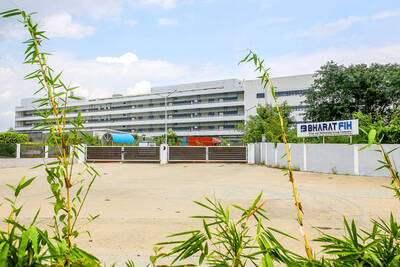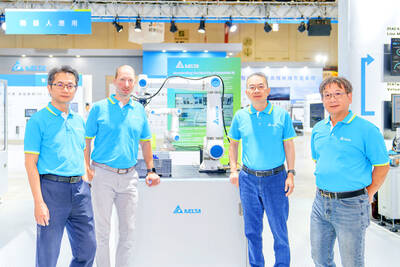Display panel maker AU Optronics Co (AUO, 友達光電) yesterday said that first-quarter net profit hit a 13-year high of NT$11.83 billion (US$423.26 million), as the COVID-19 pandemic-induced stay-at-home economy stimulated demand for panels for TVs and computers.
AUO expects the growth momentum to carry through the rest of the year and be sustainable in the longer term as work from home, remote schooling and home entertainment become the new norm.
A continued component supply crunch has added to the supply-demand imbalance in the panel industry, the company said.

Photo: CNA
“We are seeing very strong demand during the second quarter. We have clear order visibility until the end of this year. Some customers have approached us to discuss supply for next year,” AUO chairman Paul Peng (彭双浪) told an investors’ teleconference.
AUO usually starts new supply contract negotiations in October or November, Peng said.
“Overall, supply continues to be tight. Our factories have been running at full capacity since the middle of last year. We still cannot fully satisfy customers’ demand,” he said.
Addressing investors’ concern about overbooking risks, Peng said that “it is still manageable,” as customers are facing a significant supply gap of between 10 and 30 percent.
With shortages in the supply chain likely to persist, AUO expects its average selling prices to rise sequentially by a low-teen percentage this quarter, following a quarterly hike of 12.7 percent, or 43 percent annually, to US$424 per square meter last quarter.
Shipments this quarter should inch up by a low-single-digit percentage sequentially, capped by tight supplies of chips, glass substrates and other key components.
Certain production lines would also be temporarily halted for annual maintenance, leading to a slide in output, it said.
The COVID-19 pandemic has spurred demand for larger and higher-spec panels for TVs, monitors and notebooks as people tend to spend a longer time in front of their screens, AUO said.
AUO also has a more optimistic view of long-term prospects, with the display industry getting out of a boom-and-bust cycle, as Chinese manufacturers curb expansion without government support.
“Competition in the industry is no longer distorted, but has returned to normal market mechanisms,” Peng said.
Under such a benign competitive landscape, AUO should make stable profits in the next few years, Peng said.
During the quarter ending March 31, net profit surged to NT$11.83 billion, reversing losses of NT$4.99 billion in the same period last year.
On a quarterly basis, net profit soared about 40 percent from NT$8.44 billion in the final quarter of last year.
Gross margin improved to 22 percent last quarter, from 16.9 percent the previous quarter and minus-0.7 percent a year earlier.
AUO plans to budget NT$22 billion for capital expenditure this year, up 41 percent from NT$15.6 billion last year.

SETBACK: Apple’s India iPhone push has been disrupted after Foxconn recalled hundreds of Chinese engineers, amid Beijing’s attempts to curb tech transfers Apple Inc assembly partner Hon Hai Precision Industry Co (鴻海精密), also known internationally as Foxconn Technology Group (富士康科技集團), has recalled about 300 Chinese engineers from a factory in India, the latest setback for the iPhone maker’s push to rapidly expand in the country. The extraction of Chinese workers from the factory of Yuzhan Technology (India) Private Ltd, a Hon Hai component unit, in southern Tamil Nadu state, is the second such move in a few months. The company has started flying in Taiwanese engineers to replace staff leaving, people familiar with the matter said, asking not to be named, as the

The prices of gasoline and diesel at domestic fuel stations are to rise NT$0.1 and NT$0.4 per liter this week respectively, after international crude oil prices rose last week, CPC Corp, Taiwan (台灣中油) and Formosa Petrochemical Corp (台塑石化) announced yesterday. Effective today, gasoline prices at CPC and Formosa stations are to rise to NT$27.3, NT$28.8 and NT$30.8 per liter for 92, 95 and 98-octane unleaded gasoline respectively, the companies said in separate statements. The price of premium diesel is to rise to NT$26.2 per liter at CPC stations and NT$26 at Formosa pumps, they said. The announcements came after international crude oil prices

STABLE DEMAND: Delta supplies US clients in the aerospace, defense and machinery segments, and expects second-half sales to be similar to the first half Delta Electronics Inc (台達電) expects its US automation business to remain steady in the second half, with no signs of weakening client demand. With demand from US clients remaining solid, its performance in the second half is expected to be similar to that of the first half, Andy Liu (劉佳容), general manager of the company’s industrial automation business group, said on the sidelines of the Taiwan Automation Intelligence and Robot Show in Taipei on Wednesday. The company earlier reported that revenue from its automation business grew 7 percent year-on-year to NT$27.22 billion (US$889.98 million) in the first half, accounting for 11 percent

A German company is putting used electric vehicle batteries to new use by stacking them into fridge-size units that homes and businesses can use to store their excess solar and wind energy. This week, the company Voltfang — which means “catching volts” — opened its first industrial site in Aachen, Germany, near the Belgian and Dutch borders. With about 100 staff, Voltfang says it is the biggest facility of its kind in Europe in the budding sector of refurbishing lithium-ion batteries. Its CEO David Oudsandji hopes it would help Europe’s biggest economy ween itself off fossil fuels and increasingly rely on climate-friendly renewables. While